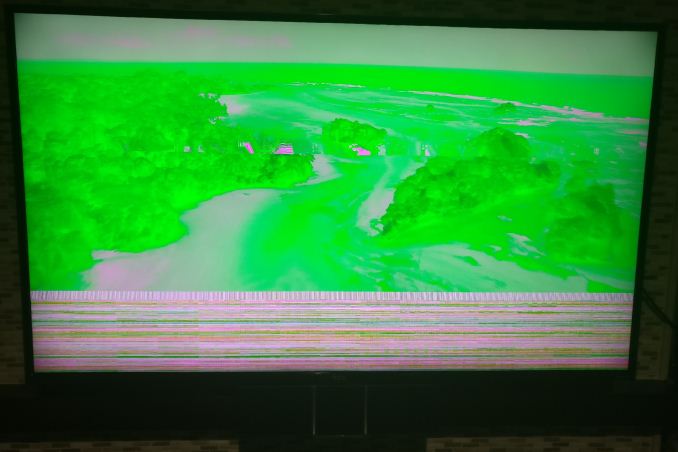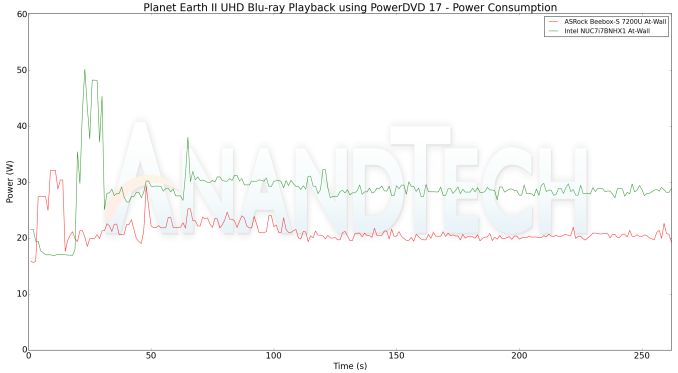A Budget Home Theater & PC Setup: 4K, HDR, UHD Blu-ray, and More
by Ganesh T S on December 26, 2017 8:30 AM ESTUHD Blu-ray Playback in Action
Prior to testing out HDR UHD Blu-ray playback using the TCL 55P607 and the Denon AVR X3400H, we did a trial run with the LG 43UD79-B monitor. The playback was flawless in SDR mode. Emboldened by these results, we moved the hardware to the home theater setup. At that time, the Windows 10 Fall Creators Update was yet to be released. Intel and CyberLink had adopted their own scheme to activate HDR in full screen mode while playing back HDR-enabled titles. Unfortunately, the TCL 55P607 (on firmware version 7.7.0 at that time) did not really like the mode switch.
Corrupted HDR Display with TCL 55P607 Firmware v7.7
I reached out to both Intel and TCL with the above results. While the latter simply washed their hands off the issue, Intel was very responsive. They went to the extent of even sourcing the same display to check at their end. Around the same time, TCL released a firmware update (v8.0.0 4127-30) that resolved the problem.
By the time I was able to upgrade my TV, Windows 10 Fall Creators Update had released and Intel's 4877 driver had also become public. My next testing round had interesting results. The 4877 driver had flawless desktop and streaming HDR, but, playing back the Planet Earth II title resulted in a BSOD, or a PowerDVD crash, or a message indicating that PowerDVD was denied access to the graphics hardware. With an older driver version (4771), I was able to play back the Blu-ray with HDR, but, had no desktop or streaming HDR.
On checking with Intel again, it became evident that the issue was specific to the Planet Earth II title. They provided me with early access to a driver slated for release in January 2018. This driver enabled both the Intel NUC7i7BNHX and the ASRock Beebox-S 7200U to successfully play back the Planet Earth II Blu-ray with HDR, while also performing as per specifications in our other tests detailed in the previous sections.
Note that the Pioneer BDR-211UBK comes with an OEM version of PowerDVD 14 that does support 4K UHD Blu-ray playback.
We tracked the power consumption of the set (PC + Blu-ray drive with the SATA-USB bridge) while playing the first chapter of the first disc in the Blu-ray set (after a full menu loop).
We find that the Beebox-S 7200U is more power efficient for this particular task. The NUC7i7BNHX is much more versatile with its Thunderbolt 3 ports, Optane support, and other bells and whistles. Can those make a difference in a generic HTPC setup? We will address that in our concluding section.













191 Comments
View All Comments
Lord of the Bored - Wednesday, December 27, 2017 - link
He didn't use a DVD player. He used a BluRay player. Completely different.And until streaming gets better bitrates it is an incomplete replacement from a purely technical standpoint. I mean, when regular BR supplies 50 megabits per second, UHD BR is a hundred mbps, and UHD Netflix is 25 mbps, there is OBVIOUSLY a quality sacrifice that has to be made(though the UHD situation is better than HD, where Netflix is a ridiculously compact FIVE mbps. I'll take a quarter the data over a tenth any day).
I mean, if you don't care about image and sound quality, you may as well watch VHS tapes off that old CRT you found in gramma's garage. I always thought home theater builds were about getting the best experience, not a really expensive mediocre experience.
CharonPDX - Wednesday, December 27, 2017 - link
"without worrying about it getting obsolete within the the next 3 to 5 years."JFC... A home theater system should last far longer than 3-5 years...
Bullwinkle-J-Moose - Thursday, December 28, 2017 - link
"JFC... A home theater system should last far longer than 3-5 years..."---------------------------------------------------------------------------------------------
Not with DRM!
A mans gotta know his limitations (Clint Eastwood)
pixelstuff - Wednesday, December 27, 2017 - link
I wish the manufacturers would create a decent set of components (AVR, Blu-ray, etc) that are not more than 8" deep so you can sit them below a wall mounted TV and they don't protrude way out into the room compared to the TV.Wiring would have to be on the sides with a standardized way to hide them, but I don't think extra width would be a big issue when placed under a large TV.
Dionysos1234 - Wednesday, December 27, 2017 - link
Recommending a Denon 999$ reciever is not only NON budget - It is also an extremely poor choice for reciever in that price range from an audio perspective. Guess HTPC is not an area where Anandtech have qualified people e.g. the amount of time devoted to showing poorly made graps on power consumption seems bizarre.Aikouka - Wednesday, December 27, 2017 - link
As for all the remarks about the receiver, my biggest piece of advice is to always buy last year's model UNLESS you absolutely need a feature only on the newest model. For example, I bought an X4300 for less than the article's X3400, and there really aren't any differences that would make me consider swapping.Aikouka - Wednesday, December 27, 2017 - link
As a quick note for the uninitiated, Denon's model numbers work where the thousands place is the model number and the hundreds place is the year. So, the 4300 that I mention above is the 4th-tier model (higher is better) from the third year. The 3400 is the third-tier model from the fourth year. So, mine is a higher model, but it's a year older. To see whether it's worth an upgrade, the AVS Forum's Denon Owner's Threads usually have comparisons to previous years (e.g. X#400 vs. X#300) that can help you decide whether the latest is worth it.r3loaded - Wednesday, December 27, 2017 - link
All I'm getting from this article is that HDR is a mess of confusing and incompatible standards and support, compounded by Hollywood's almost autistic fixation with ramming DRM down the throats of anyone wanting to watch 4K HDR content, and the very specific hardware requirements that it imposes on consumers.Also, why is it that there are tons of HDR TVs on the market but barely any HDR monitors? And conversely, why does no one make a 4K HDR TV smaller than 40 inches (say, 32 inches)? Not all of us are blessed with big houses that can fit the 55 inch TV mentioned in the review.
benedict - Wednesday, December 27, 2017 - link
Yep, sounds like too much trouble for what you're getting and you always risk some weird standard won't work on your expensive setup. Until they make this as simple as torrenting a movie the home theater market will remain a very tiny niche.CityBlue - Wednesday, December 27, 2017 - link
The BDA is expected to announce that the free to licence HDR10+ open standard is being added to the UHD BluRay standard in January at CES, and not the proprietary Dolby Vision. After that announcement I imagine DV will become a niche format. HDR10+ is simply what HDR10 should always have been.HDR10+ (compared with DV) also has a dramatically easier workflow as far as creative's are concerned, so combine that with the reduced licencing cost for manufacturers and there's very little reason to choose DV - the only winner there is Dolby.
It's not yet announced, but recommending DV over HDR10+ may not be such good advice.